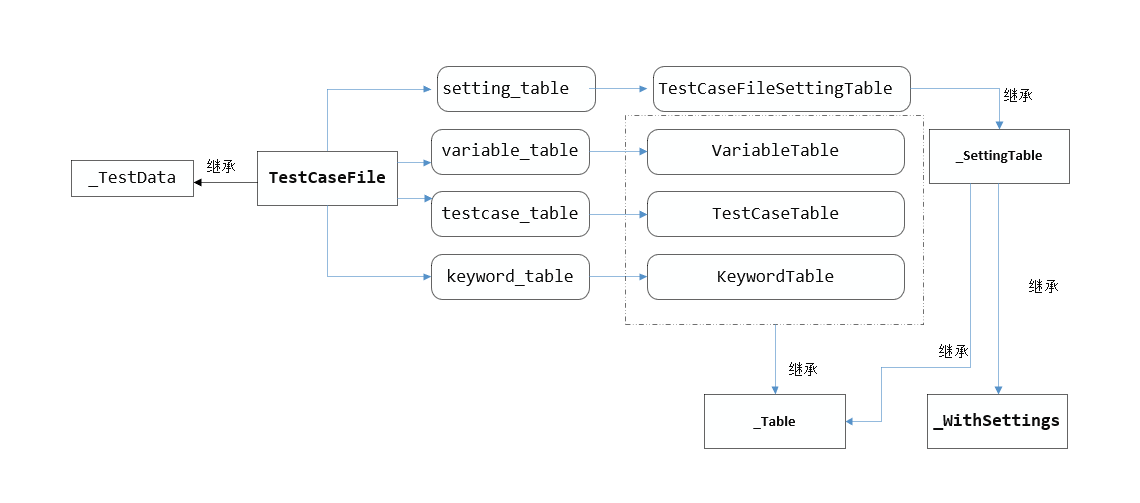RobotFramework学习系列(二)
上一篇文章大概讲了RobotFramework 构建测试套件部分。这篇文章讲一下如何从文本文件(.txt或者.robot文件)到Robot进行测试数据结构的转化。以下面的文件为例test.txt
1 *** Settings *** 2 Suite Setup Initialize 3 Suite Teardown Clear 4 Resource ../Test_Run_Call.txt 5 6 *** Test Cases *** 7 Init_Env 8 log Status is OK! 9 10 Scope_Test 11 log Status is OK!
1 def _parse(self, path): 2 try: 3 return TestData(source=abspath(path), 4 include_suites=self.include_suites, 5 warn_on_skipped=self.warn_on_skipped) 6 except DataError, err: 7 raise DataError("Parsing '%s' failed: %s" % (path, unicode(err)))
由文件到Robot数据结构主要是通过_parse这个函数来完成。也就是TestData这个函数来完成(虽然看着像一个类,但其不是哦~不要被它欺骗)
1 # robot/parsing/model.py 2 def TestData(parent=None, source=None, include_suites=None, 3 warn_on_skipped=False): 4 if os.path.isdir(source): 5 return TestDataDirectory(parent, source).populate(include_suites, 6 warn_on_skipped) 7 return TestCaseFile(parent, source).populate()
由上面的源码可以得知,此处根据传入的source类型不同,而调用不同的类。当source为文件时,调用TestCaseFile这个类进行构建,而当source为目录时,调用TestDataDirectory进行构建。这也说明,robot支持指定单独的文件(suite),也支持指定包含许多文件(Suite)目录。下面以TestCaseFile这个类进行分析。
1 class TestCaseFile(_TestData): 2 3 def __init__(self, parent=None, source=None): 4 self.directory = os.path.dirname(source) if source else None 5 self.setting_table = TestCaseFileSettingTable(self) 6 self.variable_table = VariableTable(self) 7 self.testcase_table = TestCaseTable(self) 8 self.keyword_table = KeywordTable(self) 9 _TestData.__init__(self, parent, source) 10 11 def populate(self): 12 FromFilePopulator(self).populate(self.source) 13 self._validate() 14 return self 15 16 def _validate(self): 17 if not self.testcase_table.is_started(): 18 raise DataError('File has no test case table.') 19 20 def _table_is_allowed(self, table): 21 return True 22 23 def has_tests(self): 24 return True 25 26 def __iter__(self): 27 for table in [self.setting_table, self.variable_table, 28 self.testcase_table, self.keyword_table]: 29 yield table
简单画了一下TestCaseFile所关联的类,可能会比较容易理解

TestCaseFile初始化时会赋值4种属性,包括setting_table,variable_table,testcase_table,keyword_table。通过类初始化时传递self的方式,将属性类变量与自身联系。这4种table都继承于_Table,不同的是TestCaseFileSettingTable先继承于_SettingTable,而其多继承于_Table和_WithSettings
TestCaseFile(parent, source)的构建发生发生了以下几种操作
1、TestCaseFileSettingTable(继承于_SettingTable)初始化,添加了doc,suite_setup,suite_teardown ...... 等等的内部属性,这些属性都是各种类(Documentation, Fixture,Tags,ImportList等等)的实例
2、VariableTable、TestCaseTable以及KeyWordTable(继承于_Table)初始化,这些类,主要是内部有一个列表,用于将来对解析出来的对象进行保存
好了,接下来就来到了重点populate() 这个函数真是真是,太复杂了,一个函数完成了文件解析以及往TestCaseFile类中添加各种数据
1 def populate(self): 2 FromFilePopulator(self).populate(self.source) 3 self._validate() 4 return self
这个函数主要是调用了FromFilePopulator这个类的populate函数,源码如下,这个类内部维持一个字典_populators,看到这个字典基本上就有点恍然大悟,内部就是四种解析器对应TestCaseFile内部的四种变量,可以很明确的说它们就是相互对应的。
这个对象构建的时候,创建了三个内部变量,_datafile保存了传入的TestCaseFile类实例,_poplator被赋值了一个NullPopulator()这个是一个空的解析器,只是为了占位,_curdir是获取了文件所在的位置。
populate(self, path),此处path是传入的self.source(在TestCaseFile构建时,传入的_Table中的属性),为具体的文件。具体所做的事情,已经在下面的源码中标记了。其中关键部分由_get_reader这个私有方法实现
1 READERS = {'html': HtmlReader, 'htm': HtmlReader, 'xhtml': HtmlReader, 2 'tsv': TsvReader , 'rst': RestReader, 'rest': RestReader, 3 'txt': TxtReader, 'robot': TxtReader}
1 class FromFilePopulator(object): 2 _populators = {'setting': SettingTablePopulator, 3 'variable': VariableTablePopulator, 4 'test case': TestTablePopulator, 5 'keyword': KeywordTablePopulator} 6 7 def __init__(self, datafile): 8 self._datafile = datafile 9 self._populator = NullPopulator() 10 self._curdir = self._get_curdir(datafile.directory) 11 12 def _get_curdir(self, path): 13 return path.replace('\\','\\\\') if path else None 14 15 def populate(self, path): 16 LOGGER.info("Parsing file '%s'." % path) 17 source = self._open(path) <<<================= 调用内部的私有方法,简单的打开文件而已 18 try: 19 self._get_reader(path).read(source, self) 20 except: 21 raise DataError(get_error_message()) 22 finally: 23 source.close() <<<================= 和上面向对应,关闭打开的文件 24 25 def _open(self, path): 26 if not os.path.isfile(path): 27 raise DataError("Data source does not exist.") 28 try: 29 # IronPython handles BOM incorrectly if not using binary mode: 30 # http://code.google.com/p/robotframework/issues/detail?id=1580 31 return open(path, 'rb') 32 except: 33 raise DataError(get_error_message()) 34 35 def _get_reader(self, path): 36 extension = os.path.splitext(path.lower())[-1][1:] <<<========获取文件的扩展名,假如文件为test.txt,extension为txt,如果文件为test.robot,extension为robot 37 try: 38 return READERS[extension]() <<<=========根据文件扩展名不同,从READERS中获取处理文件的类名,并实例化(通过 “()”) 39 except KeyError: 40 raise DataError("Unsupported file format '%s'." % extension) 41 42 def start_table(self, header): 43 self._populator.populate() 44 table = self._datafile.start_table(DataRow(header).all) 45 self._populator = self._populators[table.type](table) \ 46 if table is not None else NullPopulator() 47 return bool(self._populator) 48 49 def eof(self): 50 self._populator.populate() 51 52 def add(self, row): 53 if PROCESS_CURDIR and self._curdir: 54 row = self._replace_curdirs_in(row) 55 data = DataRow(row) 56 if data: 57 self._populator.add(data) 58 59 def _replace_curdirs_in(self, row): 60 return [cell.replace('${CURDIR}', self._curdir) for cell in row]
这里以txt文件为例,READERS[extension]()返回的是TxtReader(),TxtReader实际继承于TsvReader。可以直接看TsvReader的源码。
读文件部分,RobotFramework单独封装了一个Uft8Reader类,保证读出来的数据不会出现编码问题。Utf8Reader(tsvfile).readlines()只是简单的返回数据单独行的一个列表。相当于file.readlines()
主要处理的部分是11~16行。process为标志处理
1 NBSP = u'\xA0' 2 3 4 class TsvReader(object): 5 6 def read(self, tsvfile, populator): 7 process = False 8 for row in Utf8Reader(tsvfile).readlines(): 9 row = self._process_row(row) <<<========= 处理空格 10 cells = [self._process_cell(cell) for cell in self.split_row(row)] <<<=========处理换行符 以及包含 | |的行 11 if cells and cells[0].strip().startswith('*') and \ 12 populator.start_table([c.replace('*', '') for c in cells]): 13 process = True 14 elif process: 15 populator.add(cells) 16 populator.eof() 17 18 def _process_row(self, row): 19 if NBSP in row: 20 row = row.replace(NBSP, ' ') 21 return row.rstrip() 22 23 @classmethod 24 def split_row(cls, row): 25 return row.split('\t') 26 27 def _process_cell(self, cell): 28 if len(cell) > 1 and cell[0] == cell[-1] == '"': 29 cell = cell[1:-1].replace('""', '"') 30 return cell
此时populator实例为FromFilePopulator(), start_table传入的变量为每一行数据去除*的部分,如文章开头定义的test.txt,此时传入的数据为Settings,注意,此时row会处理成cells,为一个列表类型。start_table的主要作用是解析文件的各个部分的头部,确定下面的部分由哪个解析器进行解析。
1 def start_table(self, header): 2 self._populator.populate() 3 table = self._datafile.start_table(DataRow(header).all) 4 self._populator = self._populators[table.type](table) \ 5 if table is not None else NullPopulator() 6 return bool(self._populator)
DataRow会将文件的行数据(此时为行数据的列表)进行转化,并根据是否以"#"开头转化成comment。这个类内置很多使用@property进行获取的属性DataRow(header).all便是返回所有非#开头的字段
此处self._datafile为上文提到的TestCaseFile类实例,所以此时调用的start_table是为TestCaseFile的方法,而这个方法是从_TestData继承来的
1 def start_table(self, header_row): 2 try: 3 table = self._tables[header_row[0]] 4 except (KeyError, IndexError): 5 return None 6 if not self._table_is_allowed(table): 7 return None 8 table.set_header(header_row) 9 return table
header_row[0]所取即为刚刚所讲DataRow(header).all中的第一个数据,拿文章开头的文件为例,即为Settings。
self._tables 实际为TestCaseFile初始化时,构成的一个字典映射,贴一下代码和实际结构,构造在初始化时。其中self.setting_table,self.variable_table即为刚开始讲TestCaseFile时所列的四个变量对应的类实例~是不是有似曾相识的感觉
1 class _TestData(object): 2 _setting_table_names = 'Setting', 'Settings', 'Metadata' 3 _variable_table_names = 'Variable', 'Variables' 4 _testcase_table_names = 'Test Case', 'Test Cases' 5 _keyword_table_names = 'Keyword', 'Keywords', 'User Keyword', 'User Keywords' 6 7 def __init__(self, parent=None, source=None): 8 self.parent = parent 9 self.source = utils.abspath(source) if source else None 10 self.children = [] 11 self._tables = utils.NormalizedDict(self._get_tables()) 12 13 def _get_tables(self): 14 for names, table in [(self._setting_table_names, self.setting_table), 15 (self._variable_table_names, self.variable_table), 16 (self._testcase_table_names, self.testcase_table), 17 (self._keyword_table_names, self.keyword_table)]: 18 for name in names: 19 yield name, table 20 21 def start_table(self, header_row): 22 try: 23 table = self._tables[header_row[0]] 24 except (KeyError, IndexError): 25 return None 26 if not self._table_is_allowed(table): 27 return None 28 table.set_header(header_row) 29 return table

此处table通过字典和key,可以选出具体是哪个table,如果是Settings,则为TestCaseSettingTable,如果是Test Cases,则为TestCaseTable 等等。。
此处拿TestCaseSettingTable为例,后执行set_header(head_now),此处是为了兼容老的头部写法,这块可以看一下代码,很简单
Ok。table的具体实例拿到了。
1 self._populator = self._populators[table.type](table) if table is not None else NullPopulator()
table.type是获取table的属性,为setting. self._populators,文章前面也讲过,是四种映射组成的字典。ok,确定了数据为Setting类型,那么解析器就是SettingTablePopulator了。所以self._populator的赋值同样找到了。
go on~
按照robot文件的写法,头部完成后,会根据头部,确定下面的写法。后续调用populator.add(cells)对后续的数据继续解析,解析器解析其中的数据往table中写入数据。
基本的逻辑就是:
需要解析文件(TeseCaseFile),需要对应解析的解析器(FromFilePopulator),所以需要找对应的解析器根据文件类型确定文件的读方法(TxtReader),然后根据读出来的部分,确认Section(Setting\TestCase等等)确定保存数据的表(TestCaseSettingTable, KeyWordTable等等)以及用来解析数据的解析器(SettingTablePopulator,VariableTablePopulator)等等,后续的数据解析基本上就没有问题啦




 浙公网安备 33010602011771号
浙公网安备 33010602011771号